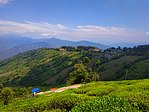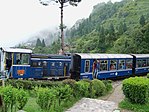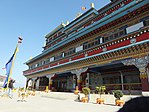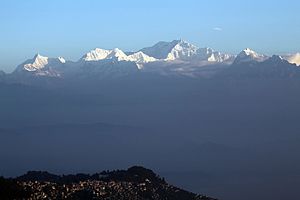Darjeeling district
Darjeeling district | |
|---|---|
|
Clockwise from top-left: Tea estate in Darjeeling, Phansidewa | |
| Area | |
| • Total | 2,092.5 km2 (807.9 sq mi) |
| Population (2011) | |
| • Total | 1,595,181 |
| • Density | 760/km2 (2,000/sq mi) |
| • Urban | 727,963 |
| Demographics | |
| • Literacy | 79.56% (excluding 0–6 population) |
| • Sex ratio | 970 |
| Time zone | UTC+05:30 (IST) |
| Major highways | NH 31, NH 55 |
| HDI (2004) | |
| Website | darjeeling |
Darjeeling District is the northernmost district of the state of West Bengal in eastern India in the foothills of the Himalayas. The district is famous for its hill station and Darjeeling tea. Darjeeling is the district headquarters.
Kurseong, Siliguri and Mirik, three major towns in the district, are the subdivisional headquarters of the district. Kalimpong was one of the subdivisions but on 14 February 2017, it officially became a separate Kalimpong district.[2]
Geographically, the district can be divided into two broad divisions: the hills and the plains. The entire hilly region of the district comes under the
Name
The etymological term of Darjeeling is denoted "Tajenglung", a
History
The ancient inhabitants of Darjeeling are the Lepcha and Limbu.
Most of Darjeeling formed a part of dominions of the Chogyal of Sikkim, who had been engaged in an unsuccessful warfare against the Gorkhas of Nepal. From 1780, the Gorkhas made several attempts to capture the entire region of Darjeeling. By the beginning of the 19th century, they had overrun Sikkim as far eastward as the Teesta River and had conquered and annexed the entire Terai.
In the meantime, the British were engaged in preventing the Gorkhas from over-running the whole of the northern frontier. The
In November 1864, the
Before 1861 and from 1870 to 1874, Darjeeling District was a "Non-Regulated Area" (where acts and regulations of the
On 14 February 2017, Kalimpong district was carved out of Darjeeling district.
Gorkhaland Movement

During the 1980s, the
The hill areas of Darjeeling enjoyed some measure of autonomy under the Darjeeling Gorkha Hill Council. However, the demand for full statehood within India has emerged once again, with the Gorkha Janmukti Morcha as its chief proponent.[6] The Gorkhaland Territorial Administration replaced the DGHC in August 2012 after the GJM signed an agreement with the government.[7]
Geography


The Darjeeling hill area is formed of comparatively recent rock structure that has a direct bearing on landslides. Heavy monsoon precipitation contributes to the landslides. Soils of Darjeeling hill areas are extremely varied, depending on elevation, degree of slope, vegetative cover and geolithology.
The Himalayas serve as the source of natural resources for the population residing in the hills as well as in the plains. As human population expands in the hills, forests are being depleted for the extension of agricultural lands, introduction of new settlements, roadways, etc. The growing changes coming in the wake of urbanisation and industrialisation leave deep impressions on the hill ecosystem.
The economy of Darjeeling hill area depends on tea production, horticulture, agriculture, forestry and tourism. The major portions of the forests are today found at elevations of 2,000 metres (6,600 ft) and above. The area in between 1,000 and 2,000 metres (3,300 and 6,600 ft) is cleared either for tea plantation or cultivation. About 30 percent of the forest covers found in the lower hills are deciduous. Evergreen forest constitutes only about 6 percent of the total forest coverage. Shorea robusta remains the most prominent species of tropical moist deciduous forest along with heavy undergrowth.
Teesta, Rangeet, Mechi, Balason, Mahananda and Rammam are the important rivers of the district.
Climate
| Climate data for Darjeeling | |||||||||||||
|---|---|---|---|---|---|---|---|---|---|---|---|---|---|
| Month | Jan | Feb | Mar | Apr | May | Jun | Jul | Aug | Sep | Oct | Nov | Dec | Year |
| Record high °C (°F) | 16 (61) |
17 (63) |
23 (73) |
24 (75) |
25 (77) |
24 (75) |
25 (77) |
25 (77) |
25 (77) |
23 (73) |
19 (66) |
17 (63) |
25 (77) |
| Mean daily maximum °C (°F) | 8 (46) |
9 (48) |
14 (57) |
17 (63) |
18 (64) |
18 (64) |
19 (66) |
18 (64) |
18 (64) |
16 (61) |
12 (54) |
9 (48) |
15 (58) |
| Mean daily minimum °C (°F) | 2 (36) |
2 (36) |
6 (43) |
9 (48) |
12 (54) |
13 (55) |
14 (57) |
14 (57) |
13 (55) |
10 (50) |
6 (43) |
3 (37) |
9 (48) |
| Record low °C (°F) | −3 (27) |
−2 (28) |
−1 (30) |
1 (34) |
6 (43) |
8 (46) |
9 (48) |
11 (52) |
10 (50) |
4 (39) |
2 (36) |
−1 (30) |
−3 (27) |
| Average precipitation mm (inches) | 13 (0.5) |
28 (1.1) |
43 (1.7) |
104 (4.1) |
216 (8.5) |
589 (23.2) |
798 (31.4) |
638 (25.1) |
447 (17.6) |
130 (5.1) |
23 (0.9) |
8 (0.3) |
3,037 (119.6) |
| Source: http://www.bbc.co.uk/weather/world/city_guides/results.shtml?tt=TT004930 | |||||||||||||
Area

Subdivisions
Darjeeling District comprises four subdivisions:
Assembly constituencies

The district was previously divided into six
- Darjeeling(assembly constituency no. 23)
- Kurseong(assembly constituency no. 24)
- Matigara-Naxalbari (SC)(assembly constituency no. 25)
- Siliguri(assembly constituency no. 26)
- Phansidewa (ST)(assembly constituency no. 27)
Phansidewa constituency is reserved for Scheduled Tribes (ST) candidates. Matigara-Naxalbari constituency is reserved for Scheduled Castes (SC) candidates. Along with one assembly constituency from
Demographics
| Year | Pop. | ±% p.a. |
|---|---|---|
| 1901 | 265,780 | — |
| 1911 | 279,899 | +0.52% |
| 1921 | 294,237 | +0.50% |
| 1931 | 332,061 | +1.22% |
| 1941 | 390,899 | +1.64% |
| 1951 | 459,617 | +1.63% |
| 1961 | 624,640 | +3.12% |
| 1971 | 781,777 | +2.27% |
| 1981 | 1,024,269 | +2.74% |
| 1991 | 1,299,919 | +2.41% |
| 2001 | 1,609,172 | +2.16% |
| 2011 | 1,846,823 | +1.39% |
| source:[10] | ||



According to the
In 2001, the population of the district was 1,609,172. The rural population was 1,088,740 and urban population was 520,432. Total males were 830,644 and females were 778,528. The density of population was 511 per km2. The decennial population growth rate (1991–2001) was 23.79%.[13]
The hills have a population of 624,061 which is nearly 40% of the population. The original inhabitants of the Darjeeling Hills were the
In the plains, the
Religion
| Religion | Population (1941)[16]: 90–91 | Percentage (1941) | Population (2011)[15] | Percentage (2011) |
|---|---|---|---|---|
| Hinduism |
142,568 | 47.95% | 1,213,326 | 76.06% |
| Tribal religion |
109,627 | 36.87% | 12,460 | 0.78% |
| Islam |
8,801 | 2.96% | 101,088 | 6.34% |
| Christianity |
1,885 | 0.63% | 104,395 | 6.54% |
| Buddhism |
--- | --- | 156,552 | 9.81% |
| Others[a] | 34,446 | 11.59% | 7,360 | 0.47% |
| Total Population | 297,327 | 100% | 1,595,181 | 100% |
Hinduism is the majority religion in both the hills and plains. Buddhism and Kirat Mudhum are almost entirely present in the hills. Christianity is primarily in the hills, although there are significant numbers among the tea tribes in the plains. Islam is almost entirely found in the plains[15]
Languages
At the time of the 2011 census, 39.88% of the population spoke
Bengali is the official language of the district, with Nepali declared as co-official only in Darjeeling and Kurseong subdivisions.[19][14]
Nepali is the dominant language in the hill divisions, spoken by more than 90% of the people in Darjeeling, Kurseong and Mirik subdivisions, although most hill inhabitants are not from Khas communities. Several hundred of the original hill inhabitants still speak their original languages although the vast majority now speak only Nepali.[17]
The main language of the Siliguri subdivision is Bengali. It is followed by a sizable number of Kamatpuri or Rajbongshi speakers. Among the Adivasis, Sadri is the main language although some still speak their original languages like Kurukh, Mundari and Santali.[17]
Flora and fauna
Darjeeling district is home to
Darjeeling district has three
See also
References
- ^ "West Bengal Human Development Report 2004" (PDF). Archived (PDF) from the original on 26 January 2018. Retrieved 23 August 2022.
- ^ "West Bengal CM congratulates people of Kalimpong district". The Times of Indial. 2017. Retrieved 18 February 2017.
- ^ a b c d e f g "District Census Handbook: Darjeeling" (PDF). censusindia.gov.in. Registrar General and Census Commissioner of India. 2011. Archived (PDF) from the original on 18 April 2023. Retrieved 18 April 2023.
- ^ Subba U.,( 'Sabdatitma Tajenglung' (Title) by Sankarhang Subba,) (Editor) Yuma Manghim Udghatan Samaroha Smarika 2017, Nalichour, Sonada, published by Limbu/ Subba Tribal Society, Darjeeling.
- ^ "Pre-Independence [Darjeeling]". Government of Darjeeling. Archived from the original on 31 October 2015. Retrieved 17 August 2015.
- ^ "Gorkhaland State a distinct possibility". The Hindu. Chennai, India. 15 May 2004. Archived from the original on 6 July 2004.
- ^ "Gorkha Territorial Administration members sworn in; Shinde, Mamata assure support". The Times of India. 5 August 2012. Archived from the original on 4 August 2012. Retrieved 5 August 2012.
- ^ "General election to the Legislative Assembly, 2001 – List of Parliamentary and Assembly Constituencies" (PDF). West Bengal. Election Commission of India. Archived from the original (PDF) on 4 May 2006. Retrieved 16 November 2008.
- ^ "Press Note, Delimitation Commission" (PDF). Assembly Constituencies in West Bengal. Delimitation Commission. Archived (PDF) from the original on 8 January 2011. Retrieved 16 November 2008.
- ^ "Decadal Variation In Population Since 1901". Archived from the original on 8 August 2019. Retrieved 8 August 2019.
- ^ US Directorate of Intelligence. "Country Comparison:Population". Archived from the original on 13 June 2007. Retrieved 1 October 2011.
Kosovo 1,825,632 July 2011 est.
- ^ "Census of India : Provisional Population Totals Paper 1 of 2011 : West Bengal". Censusindia.gov.in. Archived from the original on 25 December 2018. Retrieved 13 June 2012.
- ^ "Census 2001". darjeeling.gov.in. Archived from the original on 5 March 2010. Retrieved 22 November 2021.
- ^ a b c "People and Culture - Language". Archived from the original on 25 December 2008. Retrieved 26 April 2018.
- ^ a b c "Table C-01 Population by Religion: West Bengal". censusindia.gov.in. Registrar General and Census Commissioner of India. 2011. Archived from the original on 5 April 2023. Retrieved 17 August 2022.
- ^ "Census of India, 1941 Volume VI Bengal Province" (PDF). Archived (PDF) from the original on 9 December 2017. Retrieved 13 August 2022.
- ^ a b c d "Table C-16 Population by Mother Tongue: West Bengal". www.censusindia.gov.in. Registrar General and Census Commissioner of India. Archived from the original on 9 August 2022. Retrieved 17 August 2022.
- ^ "Lok Sabha Debates - Nepali-speaking People in Darjeeling" (PDF). eparlib.nic.in. Archived (PDF) from the original on 16 April 2022. Retrieved 16 April 2022.
- ^ "Report of the Commissioner for Linguistic Minorities in India: 50th report (delivered to the Lokh Sabha in 2014)" (PDF). National Commissioner for Linguistic Minorities, Ministry of Minority Affairs, Government of India. p. 95. Archived from the original (PDF) on 8 July 2016. Retrieved 13 July 2015.
- ^ "National Parks". ENVIS Centre on Wildlife & Protected Areas. Archived from the original on 4 November 2016. Retrieved 17 February 2017.
- ^ "Wildlife Sanctuaries". ENVIS Centre on Wildlife & Protected Areas. Archived from the original on 23 February 2017. Retrieved 17 February 2017.
- ^ Including Jainism, Buddhism, Zoroastrianism, Judaism, Ad-Dharmis, or not stated





